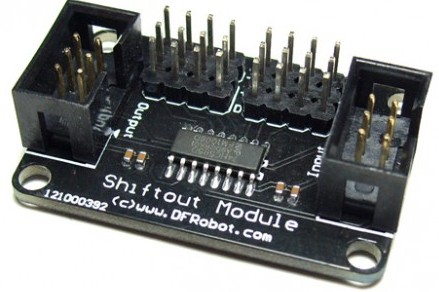Introduction
At sometime or another you may run out of pins on your Arduino board and need to extend it with shift registers. With this shift out module which is based on 74HC595. The datasheet refers to the 74HC595 as an "8-bit serial-in, serial or parallel-out shift register with output latches; 3-state." In other words, you can use it to control 8 outputs at a time while only taking up a few pins on your microcontroller. You can link multiple registers together to extend your output even more. It can also be applies to 51, AVR, PIC and other microcontroller.
Note:This module can be multipled linked,but too much modules linked may affect the working efficiency.Twenty may be better
Pin out

Connection Details
- Input:
- D3 connect to Arduino Digital 3
- D8 connect to Arduino Digital 8
- D9 connect to Arduino Digital 9
- VCC connect to Arduino 5V
- GND connect to Arduino GND
- Output:
- D3 connect to the modules' input D3
- D8 connect to the modules' input D8
- D9 connect to the modules' input D9
- VCC connect to the modules' VCC
- GND connect to the modules' GND
Code
//Pin connected to latch pin (ST_CP) of 74HC595
const int latchPin = 8;
//Pin connected to clock pin (SH_CP) of 74HC595
const int clockPin = 3;
////Pin connected to Data in (DS) of 74HC595
const int dataPin = 9;
byte Tab[]={0xc0,0xf9,0xa4,0xb0,0x99,0x92,0x82,0xf8,0x80,0x90,0xff};
void setup() {
//set pins to output because they are addressed in the main loop
pinMode(latchPin, OUTPUT);
pinMode(dataPin, OUTPUT);
pinMode(clockPin, OUTPUT);
Serial.begin(9600);
Serial.println("reset");
}
void loop() {
if (Serial.available() > 0) {
// ASCII '0' through '9' characters are
// represented by the values 48 through 57.
// so if the user types a number from 0 through 9 in ASCII,
// you can subtract 48 to get the actual value:
int bitToSet = Serial.read() - 48;
// write to the shift register with the correct bit set high:
digitalWrite(latchPin, LOW);
// shift the bits out:
shiftOut(dataPin, clockPin, MSBFIRST, Tab[bitToSet]);
// turn on the output so the LEDs can light up:
digitalWrite(latchPin, HIGH);
}
}
FAQ
For any questions, advice or cool ideas to share, please visit the DFRobot Forum.
